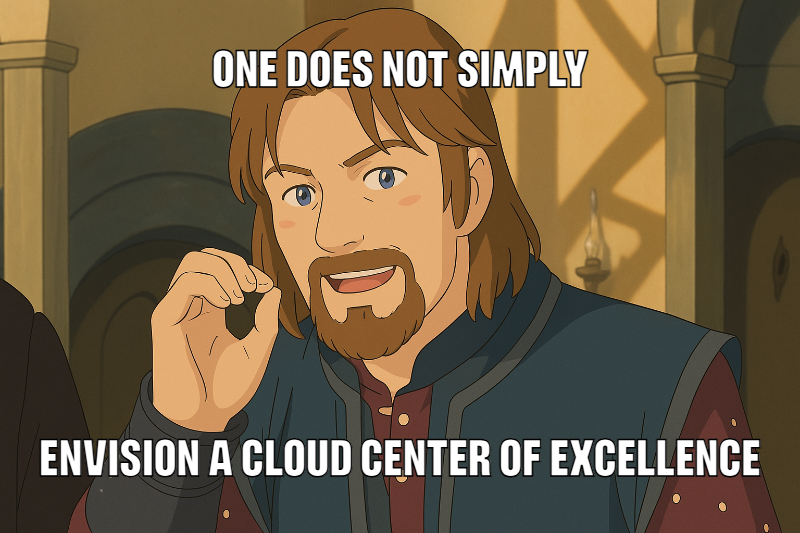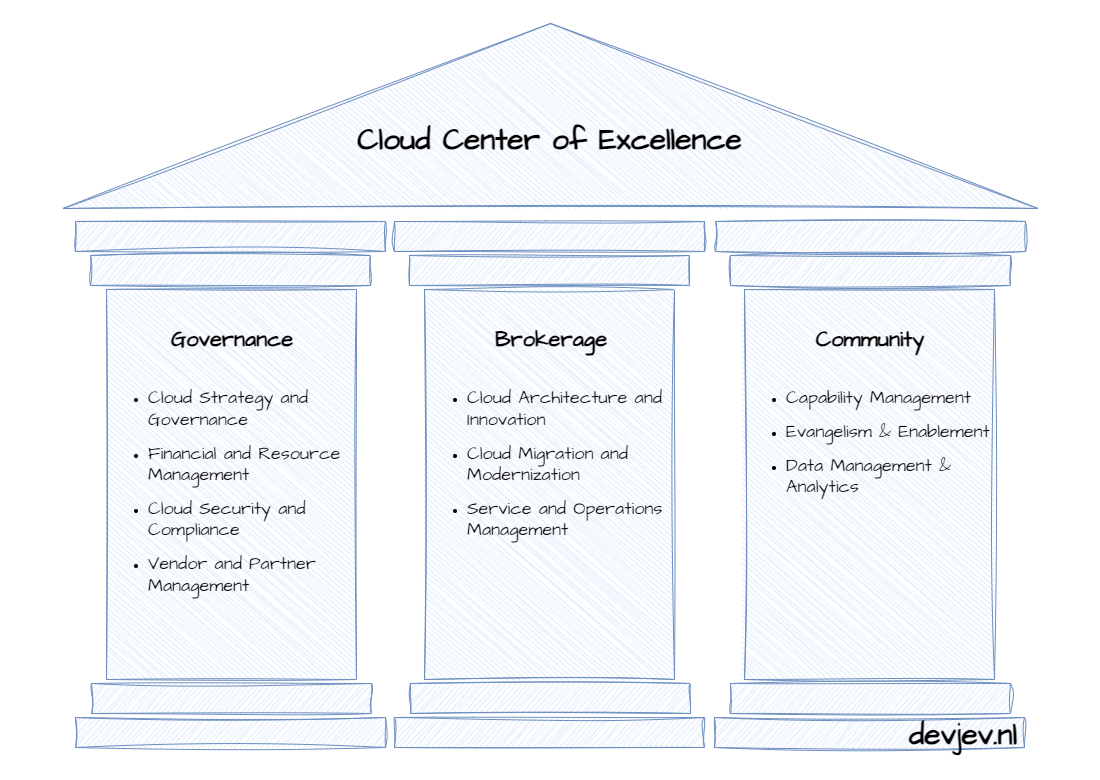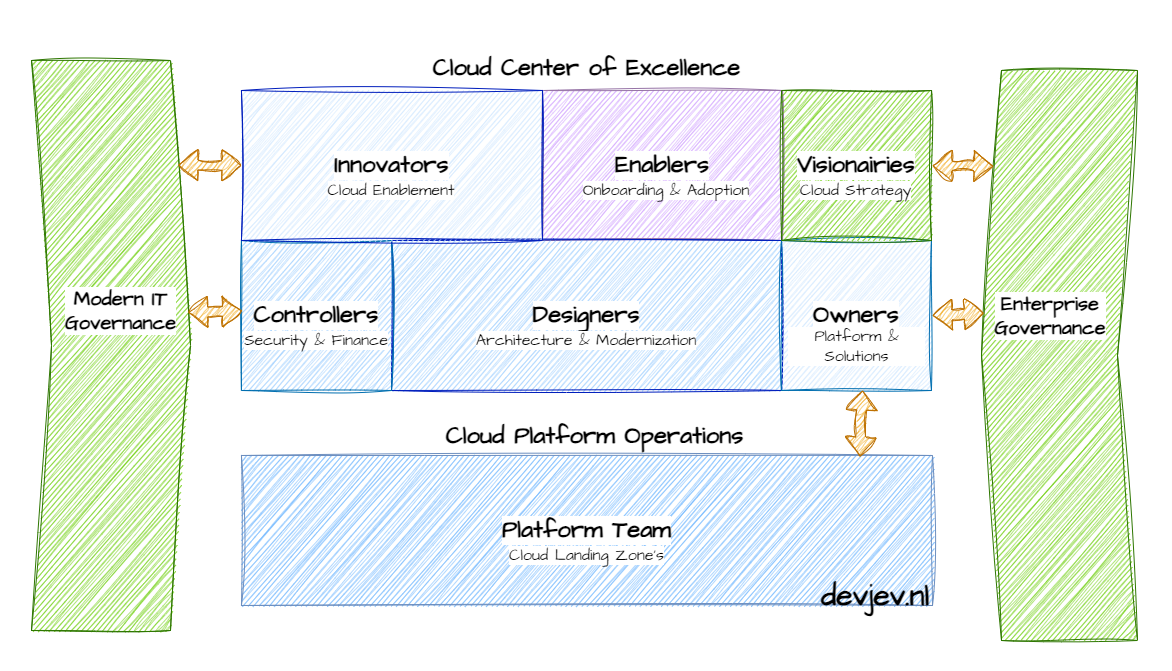🌐🏗️ Building a Cloud Center of Excellence: The Envision Stage 💡🚀

Envision Stage
In our Pathfinder journey to establish a Cloud Center of Excellence (CCoE), we begin with the Envision Stage—the first of the stages. This stage creates a common frame of reference for your organization to define the CCoE’s purpose, structure, and alignment within the organization. If you haven’t read the introduction to this series, check out the first post: Building a Cloud Center of Excellence: The Pathfinder Journey .
Assembling the Pathfinder Team
Before the actual CCoE is established, a Pathfinder Team is formed. This team is responsible & accountable for implementing the Pathfinder Roadmap, a framework designed to guide organizations through cloud adoption and governance. It’s important to note that the Pathfinder Team is separate from the eventual CCoE members—it plays a critical role in shaping the foundational elements of the CCoE.
It’s important to note that this is not the definitive CCoE team but rather a group that steers its initial formation. It is often the case that a subset of individuals of the Pathfinder Team will eventually become part of the CCoE, but this is not a requirement. The Pathfinder Team should be composed of individuals with diverse skills and backgrounds. Those skills are aimed at establishing the desired target state, while a CCoE (target state) team member will put more emphasis on operating the established CCoE.
This team will:
- Research and introduce best practices related to CCoE frameworks.
- Define the vision and objectives of the CCoE.
- Identify key stakeholders and sponsors.
- Establish a framework for governance and collaboration.
- Output initial backlogs for the CCoE team to get started in sprints or iterations.
- Facilitate transition of the Pathfinder team to a permanent CCoE team.
Organizing the Envision Workshops
The Envision Stage is structured around a series of workshops that help define the scope, objectives, and structure of any CCoE according to industry-standard best practices. These workshops cover key topics, including:
1. Setting the Stage: Expected Outcomes of the Pathfinder Phase
- Defining the CCoE’s Role: Establishing an Advisory, Functional, and Prescriptive CCoE model that provides governance, best practices, and implementation guidance.
- Clarifying the Pathfinder Phase: Ensuring alignment with organizational goals and setting expectations for Cloud adoption, security, and operations.
2. Organizational Structure and CCoE Positioning
- Mapping the CCoE within the Organization according to industry standards: Understanding where the CCoE fits in the larger enterprise landscape.
- Defining Key Interactions: Establishing relationships with business units, IT teams, security teams, and governance bodies.
- Articulating a Clear Vision: Aligning with industry standards to define a robust mission statement that guides the Pathfinder team decision-making and Cloud strategy.
The CCoE will serve as a central hub for Cloud expertise, providing guidance, tools, and support to enable successful Cloud initiatives and empower teams to leverage Cloud technologies effectively.
3. The Three Pillars of a CCoE (Gartner Framework)
A successful CCoE stands on three foundational pillars:

Governance Capabilities
- Cloud Strategy and Governance: Enterprise Architecture, Cloud Strategy Development.
- Financial and Resource Management: Cost control, supplier management, capacity planning.
- Cloud Security and Compliance: Risk management, data governance, policy enforcement.
- Vendor and Partner Management: Managing cloud service providers, contracts, and procurement.
Brokerage Capabilities
- Cloud Architecture and Innovation: Solution architecture, cloud-native development, emerging technologies.
- Cloud Migration and Modernization: Application migration, data migration, modernization roadmaps.
- Service and Operations Management: Service catalog, SLAs, incident/problem/change management.
Community Capabilities
- Capability Management: Training programs, skills development, knowledge sharing.
- Evangelism & Enablement: Guidance, certifications, fostering a Cloud-first mindset.
- Data Management and Analytics: Democratization, insights, integration, and migration strategies.
4. Enhanced Operational Management Pyramid
To ensure leadership alignment across from executive- down to operational layers. This end-to-end leadership alignment is conditional to the success of the Pathfinder team’s mission. The following organizational strategy framework pyramid outlines the leadership layers:

- Executive Level – High-level vision, sponsorship, funding.
- Strategic Level – Business alignment, long-term planning.
- Enablement Level – Nurturing cross-team collaboration, culture shift, and unblocking impediments.
- Tactical Level – Implementation of best practices, frameworks.
- Operational Level – Day-to-day execution, hands-on delivery.
5. Defining CCoE Teams and Roles
A successful CCoE requires a diverse mix of teams and roles, which are:

- CCoE itself: Designers, Enablers, Innovators, Controllers, Owners, and Visionaries.
- Platform Team: Responsible for Cloud infrastructure and automation, as the executing arm of the CCoE.
Additionally, roles within the Pathfinder team should be clearly defined to ensure accountability and expertise. This needs to be ensured as the Pathfinder team is temporary by nature.
6. Finalizing the Envision Stage
Before progressing to the next phase, ensure that key stakeholders understand:
- Academic principles, market standards, and best practices that define a successful CCoE.
- Practical examples of what a CCoE should and should not be.
- Cloud fundamentals—simplified explanations of technical Cloud concepts and Agile ways of working, tailored for non-technical stakeholders.
By completing the Envision Stage, your organization establishes a strong frame of reference for a well-structured, high-impact Cloud Center of Excellence.
📌 Key Takeaways
- Industry-standard best practices by design, through early research.
- Establish a clear vision and objectives for the Pathfinder team.
- Engage key stakeholders early in the process.
- Focus on the pillars of a CCoE, governance, brokerage, and community.
- Start small, iterate fast, learn continuously.
Wrapping Up
The Envision Stage sets the first step in establishing a CCoE, by setting the Pathfinder team up for success in the best possible way. By assembling the right team, defining a clear mission, and getting leadership buy-in from the start, organizations will build a strong foundation for their Cloud journey. Stay tuned for the next stage in our Cloud Center of Excellence series, where we’ll explore the Pathfinder: Align stage.
- Microsoft Cloud Adoption Framework
- Set Up Your Organization for Cloud Adoption Success - Gartner
- Execute Your Cloud Strategy With a Cloud Center of Excellence - Gartner
- Building a CCOE to transform the entire enterprise
- The CCoE phases
- How to Build a Successful CCoE: A Step-by-Step Guide
- How to build a cloud center of excellence
- Kwartiermakersgilde
- Quartermaster - Britannica
- Quartermaster - Wikipedia
Thank you so much for taking the time to read this post. If you enjoyed it or learned something new, don’t hesitate to check out my other posts . If you have questions or feedback, feel free to reach out via LinkedIn . Until next time, happy automating! ✨